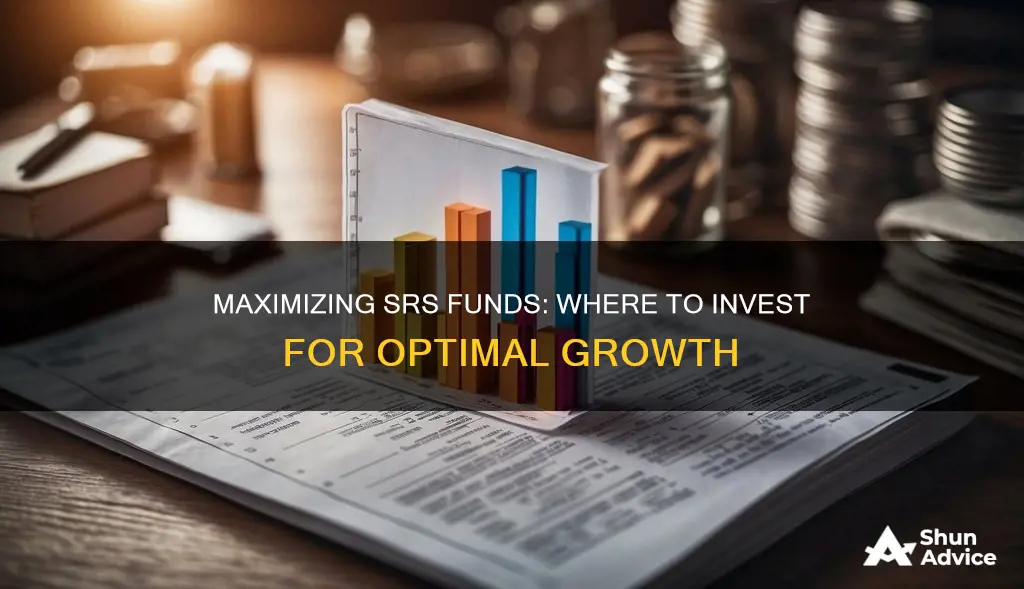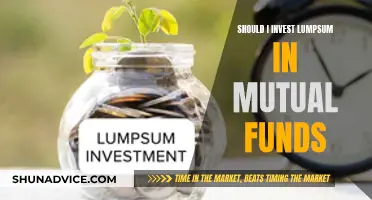
The Supplementary Retirement Scheme (SRS) is a voluntary initiative that helps Singapore citizens, permanent residents, and foreigners save for retirement while reducing their taxes. SRS account holders can invest their funds in a variety of financial products, including stocks, bonds, insurance products, and more. However, leaving SRS funds idle in a low-interest bank account can lead to the erosion of savings due to inflation. Therefore, it is important for account holders to explore investment options to maximise their savings and make their money work harder for them.
| Characteristics | Values |
|---|---|
| Maximum yearly contribution | $15,300 for Singaporeans and PRs, $35,700 for foreigners |
| Tax relief | Dollar-for-dollar tax relief of up to $15,300 for citizens and PRs, and up to $35,700 for foreigners |
| Taxable income | 50% of withdrawals after retirement age are taxable |
| Tax relief cap | $80,000 per year |
| Interest rate | 0.05% per annum |
| Investment options | Stocks, bonds, real estate investment trusts (REITs), exchange-traded funds (ETFs), insurance products, annuities, unit trusts, mutual funds, savings accounts, fixed deposits |
| Withdrawal age | 63, increasing to 65 by 2030 |
| Withdrawal window | 10 years after the first withdrawal |
| Withdrawal penalty | 5% penalty and 100% taxation for early withdrawals |
What You'll Learn

Singapore Savings Bonds (SSB)
SSB offers a step-up interest rate system, where the interest rate gets progressively higher for each year of funds staying invested in the bond. The longer you hold on to the bond, the higher the interest rate you enjoy. There is no penalty for individuals who wish to exit their investment early, and you will get your principal back (along with any accrued interest) by the second business day of the following month.
The minimum amount to invest in SSB is $500, and the investment sum should be in multiples of $500. The individual limit for SSB is currently set at $200,000, including bonds bought with cash and your SRS monies.
SSB is non-transferrable and cannot be traded in the open market, traded on the Singapore Exchange, or pledged as collateral. It is also exempt from tax in Singapore.
SSB is a good option for extremely risk-averse investors who want to earn a return on their SRSS contributions without taking on much risk. It is also suitable for retirees or those nearing retirement, as it provides a safe and flexible way to maintain the value of their nest egg.
Retirement Planning: Safely Investing for Peace of Mind
You may want to see also

Single Premium Insurance
There are four types of Single Premium Insurance Plans allowed for SRS investment:
- Wealth Accumulation Plan: A one-time premium payment plan that grows in value over time and provides a lump-sum payout in the future, at a date of your choice or maturity. It offers both guaranteed and non-guaranteed returns, with the flexibility to decide when to withdraw funds.
- Retirement Income Plan: This plan provides regular monthly or yearly income upon retirement, with the option to choose the income stream starting date. It also offers guaranteed and non-guaranteed returns, and the flexibility to structure retirement income cash flow to optimise tax savings.
- Short-Term Guaranteed Return Plan: This is a non-participating endowment plan that provides a guaranteed maturity return over a short policy term, usually three years. It is suitable for those with an investment time horizon of less than ten years and allows policyholders to access their funds without locking in their SRS money beyond their desired withdrawal time.
- Investment-Linked Plan (ILP): These plans allow lump-sum investments in chosen ILP sub-funds (Unit Trust Funds), and the returns depend on the performance of the chosen sub-funds. ILPs offer the potential for higher returns but may underperform compared to other plans if surrendered during a bear market.
It is important to note that there are restrictions on the types of insurance products that can be purchased with SRS funds. Only single-premium products, including recurrent single-premium products, are allowed, and life cover is capped at three times the single premium. Critical illness, health, and long-term care products are excluded.
Before investing in Single Premium Insurance, it is recommended to consult a financial advisor to ensure it aligns with your investment goals and risk tolerance.
The Mindset of Investment Fund Managers: Traits and Insights
You may want to see also

Unit Trusts
There are many benefits to investing in unit trusts. Firstly, they offer investment diversification, allowing you to achieve a well-rounded portfolio across various asset classes and geographies. Secondly, they are affordable and accessible, with a Regular Savings Plan requiring only a modest starting amount of S$100. Thirdly, unit trusts are professionally managed by a fund manager or a team of managers, and most offer daily subscriptions and redemptions, providing a high level of liquidity for investors.
When investing in unit trusts, it is important to choose one that matches your risk tolerance and financial goals, while considering factors like fees and performance track records. It is also crucial to be aware of the associated investment risks, as with any investment, there is a possibility of losing part or all of the invested amount.
There are several platforms that allow you to invest in unit trusts with your SRS funds, such as FSMOne, GROW with Singlife, and dollarDEX. These platforms enable you to choose the regions, sectors, and fund managers that you are comfortable investing your funds with.
By investing your SRS funds in unit trusts, you can boost your long-term retirement savings and take advantage of the potential for significant growth and diversification.
Super Funds: Where Your Money is Invested
You may want to see also

Exchange Traded Funds (ETFs)
Exchange-Traded Funds (ETFs) are a type of index fund that can be bought and sold on a stock exchange, much like a common stock. They are a basket of securities that can be traded like an individual stock on an exchange. ETFs are bought and sold through a brokerage firm on a stock exchange. They are offered on a wide range of asset classes, from traditional investments to alternative assets like commodities or currencies.
ETFs are a good investment vehicle for those looking for an affordable, potentially tax-efficient way to access a broad range of asset classes. They are also a good option for investors who want to diversify their portfolio and lower their risk and exposure.
ETFs are available on most online investing platforms, retirement account provider sites, and investing apps, many of which offer commission-free trading. After creating and funding a brokerage account, investors can search for ETFs and make their chosen buys and sells.
ETFs can be structured to track anything from the price of a commodity to a large and diverse collection of securities. They can even be designed to track specific investment strategies. There are two main types of ETFs:
- Passive ETFs: These aim to replicate the performance of a broader index, such as the S&P 500, or a more specific targeted sector or trend.
- Actively managed ETFs: These do not target an index of securities but rather have portfolio managers making decisions about which securities to include in the portfolio. Actively managed ETFs tend to have higher fees.
- SPDR S&P 500 (SPY): Tracks the S&P 500 Index
- IShares Russell 2000 (IWM): Tracks the Russell 2000 small-cap index
- Invesco QQQ (QQQ) ("cubes"): Tracks the Nasdaq 100 Index
- SPDR Dow Jones Industrial Average (DIA) ("diamonds"): Represents the 30 stocks of the Dow Jones Industrial Average
ETFs have advantages and disadvantages that should be considered before investing.
Advantages of ETFs:
- Access to many stocks across various industries
- Low expense ratios and fewer broker commissions
- Risk management through diversification
- Can focus on targeted industries
- More tax-efficient than actively managed mutual funds
Disadvantages of ETFs:
- Actively managed ETFs have higher fees
- Single-industry-focused ETFs limit diversification
- Lack of liquidity can hinder transactions
- Trading costs: If investing small amounts frequently, there may be lower-cost alternatives
- Illiquidity: Thinly traded ETFs may have wide bid/ask spreads, impacting buy and sell prices
- Tracking error: Technical issues can create discrepancies in tracking the underlying index
Climate Change Mitigation: Investing for a Sustainable Future
You may want to see also

Real Estate Investment Trusts (REITs)
REITs allow individuals to invest in large-scale, income-producing real estate. They are a way for individual investors to earn a share of the income produced through commercial real estate ownership without having to buy commercial properties.
REITs are structured as corporations and are not typically taxed at the entity level, which allows investors to avoid double taxation on dividends. They must invest in real assets and derive most of their income from real estate activities, including rents from properties and interest from mortgages.
There are two main types of REITs: Equity and Mortgage. Equity REITs own and manage properties and collect payments from tenants. They generate income from rents received from tenants in a variety of commercial and residential properties. Mortgage REITs, on the other hand, invest in mortgages and derive their income from interest payments.
REITs can be publicly traded or non-traded. Publicly traded REITs are listed on a public exchange and are highly liquid, while non-traded REITs are not listed on exchanges and are less liquid.
When investing in REITs, it is important to consider the benefits and risks. REITs typically offer higher dividend yields and provide a liquid method of investing in real estate. They can also serve as a hedge against inflation. However, they are subject to real estate market risks, interest rate risk, occupancy rate risk, geographic risk, and business risk.
Before investing in a REIT, it is important to understand whether it is publicly traded or non-traded, as this affects the benefits and risks associated with the investment. Non-traded REITs, for example, may have lower liquidity and higher upfront fees.
REITs can be a good investment option for those looking to include real estate in their portfolio, but it is important to carefully consider the risks and do your own research before investing.
IRA and Mutual Funds: A Smart Investment Strategy
You may want to see also
Frequently asked questions
The Supplementary Retirement Scheme (SRS) is a voluntary initiative that forms part of Singapore’s multi-pronged strategy to help citizens, permanent residents (PRs), and foreigners start building their retirement savings.
SRS contributions are eligible for dollar-for-dollar tax relief of up to $15,300 for citizens and PRs and up to $35,700 for foreigners. This means you can reduce your final tax payable by getting a tax relief on your SRS contributions, which reduces your chargeable income.
You can invest your SRS funds in a variety of financial products, including stocks listed on the Singapore Exchange (SGX), real estate investment trusts (REITs), Exchange-Traded Funds (ETFs), bonds, single-premium insurance, unit trusts, and more.







